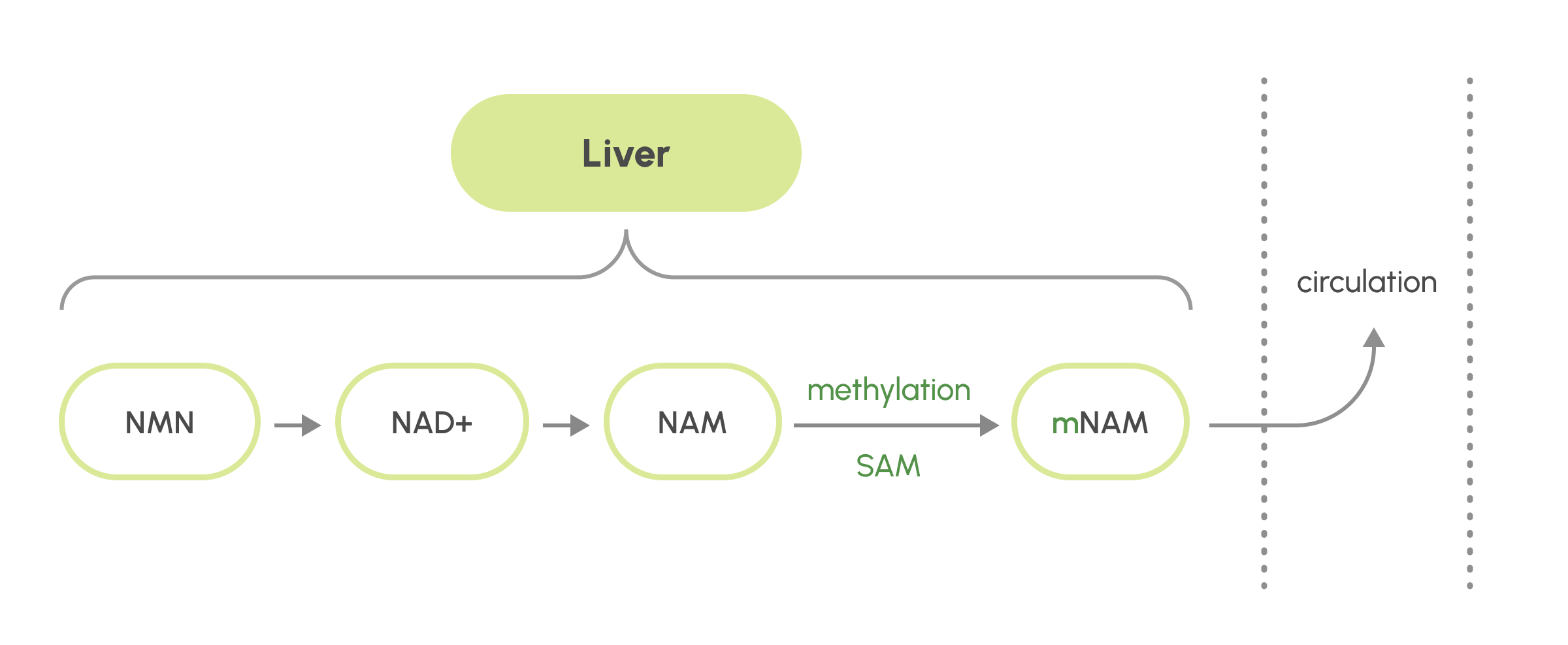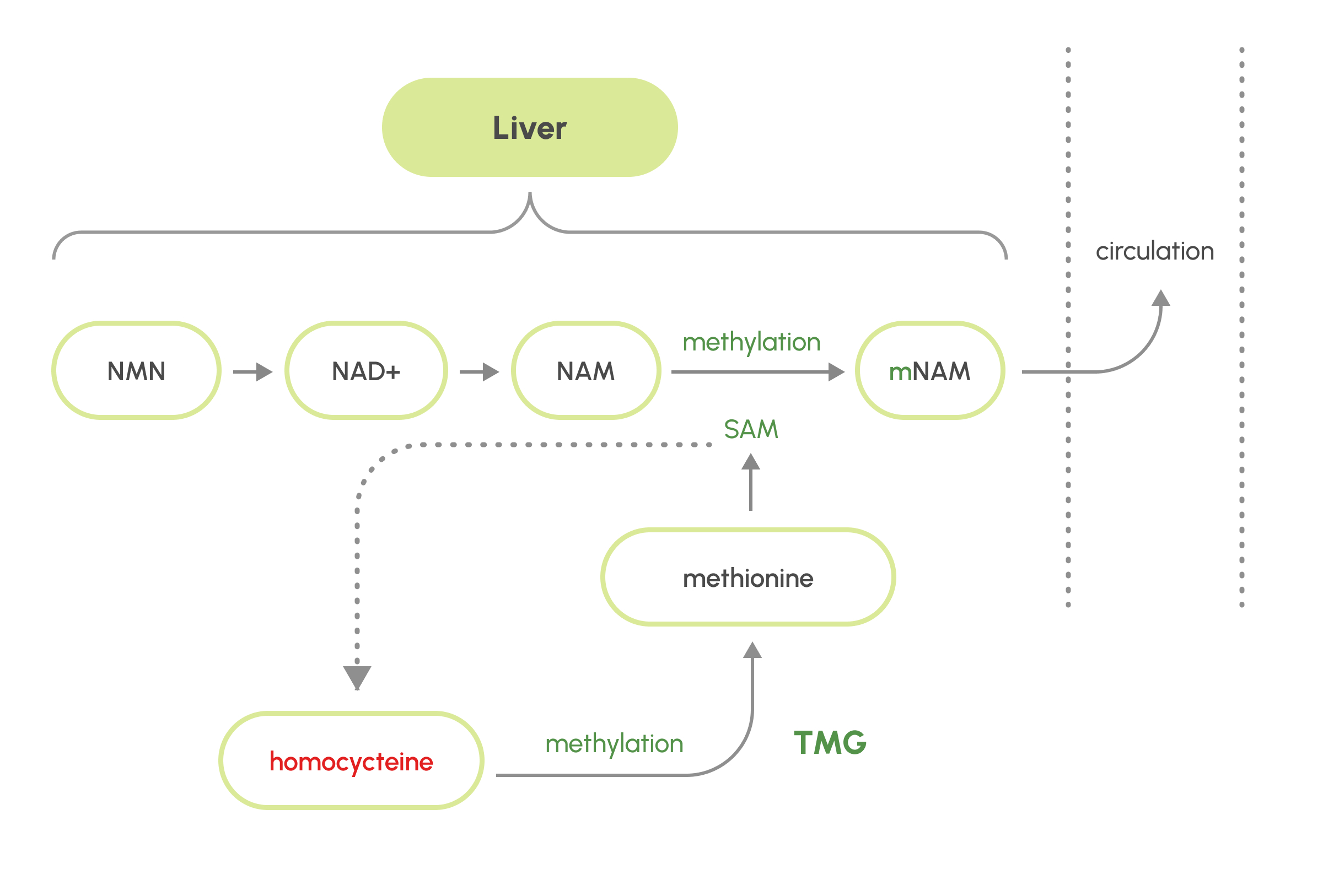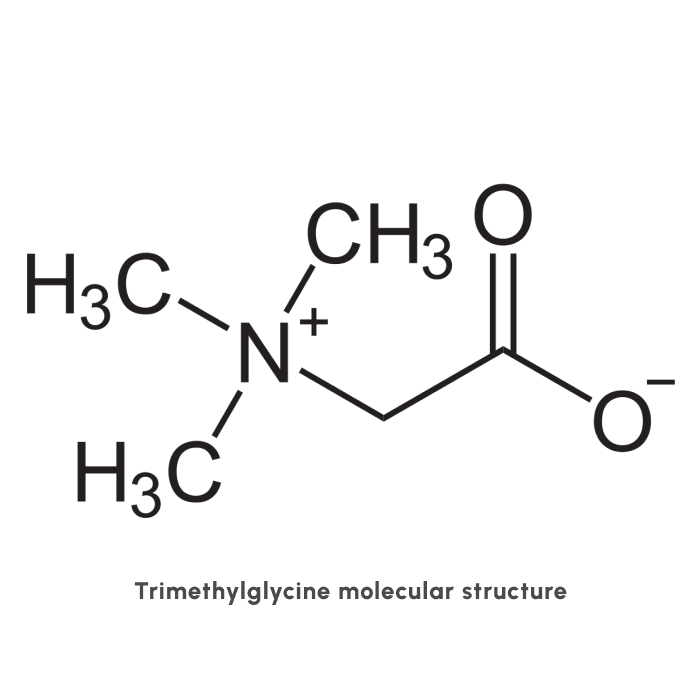The Science Behind TMG (Trimethylglycine)
TMG
TMG stands for trimethylglycine, a long name for a short molecule. As its name indicates, TMG is a glycine with three methyl groups (Figure 1). Glycine is an amino acid, a building block of proteins. A methyl group is one carbon atom surrounded by three hydrogens. We can synthesize our own TMG. We also receive it from our diets and especially wheat bran, wheat germ, wheat bread, spinach and beets (1). TMG was first found in beet (Beta bulgaris), this is why it is also known as betaine or betaine glycine. Today, more betaines are known.

Figure 1: TMG. TMG is a trimethyl-glycine. A glycine molecule with three methyl groups (in green).
TMG has enough methyl groups to spare
With three methyl groups, TMG is a generous methyl donor! That means it gives its methyl groups to other molecules, like proteins or DNA, in a process called methylation. Methylation can change the properties of molecules and it is crucial for many functions of the cell. For example, DNA methylation regulates gene expression. Changes in DNA methylation patterns (not necessarily the amount of methylation) occur during aging and in diseases like cancer (2).
TMG balances NMN supplementation
Methylation is very important in the metabolism of NMN and NAD. NAD is vital for energy production and the activity of elemental proteins like sirtuins (longevity) and PARP (DNA repair) (3,4). However, NAD levels drop with age 5. This can be reversed with NMN supplementation according to clinical trials (6,7).
In the liver, after NAD+ interacts with its partners (like sirtuins), part of it needs to be excreted in circulation. This is where methylation comes in. For NAD+ to be secreted, it is transformed into NAM and NAM after methylation becomes mNAM (methylNAM) (8) (Figure 2). mNAM is the form that is secreted in the blood stream.

Figure 2: NAD metabolism pathway, simplified (8). In the liver, NMN (endogenous or supplemented) is converted to NAD+ that interacts with sirtuins, PARP, etc. After this interaction NAD+ is converted to NAM. NAM needs to be methylated (from SAM) to mNAM to be excreted from the liver in the circulation. Methyl groups and methyl donors are in green.
Increased levels of NAD after NMN supplementation led to higher needs for methyl groups to produce mNAM. Because the methyl pool in the cell is not infinite, Harvard Professor Dr David Sinclair suggests boosting it by taking TMG (9). Even though TMG is not the default methyl donor for mNAM, the idea is that it will help keep in balance the methyl groups in the cell. This is how TMG balances out the action of NMN.
TMG lowers homocysteine levels
TMG may not be the default methyl donor for NAM but it is for homocysteine. Homocysteine is an amino acid that becomes toxic in high concentrations and is related to cardiovascular and neurodegenerative diseases. So, its levels need to be kept in check. One way to do that is methylation of homocysteine by TMG (or B vitamins), mainly in the liver. Clinical trials have proven that TMG significantly decreases homocysteine levels (10). Upon methylation by TMG, homocysteine becomes methionine.

Figure 3: TMG methylates homocysteine to methionine, thereby keeping homocysteine levels low.
Methionine is an essential amino acid and one more link between TMG and NAD (11).

Figure 4: Homocysteine metabolism is connected with NAD+ metabolism 8. Methionine is converted to the methyl donor SAM that will methylate NAM to mNAM. For the whole system to be balanced there need to be enough methyl donors (TMG and SAM). Methyl groups and methyl donors are in green.
High levels of homocysteine are associated with risk for cardiovascular disease (12). However, there has been controversy over the effects of TMG on cardiovascular markers. Some scientists suggest it improves while others it deteriorates these markers. A recent meta-analysis of 12 clinical trials concluded that less than 4g TMG per day decreases homocysteine without affecting the lipid load. Greater doses, on the contrary, elevated total cholesterol and low-density lipoprotein (LDL) (10). Both doses had similar results in lowering homocysteine levels.
Alzheimer’s disease (AD) is also associated with high homocysteine levels. In a clinical trial involving 67 AD patients, doses up to 200 μg/kg TMG for 1 month were tested (13). This dose corresponds to 0.014g for a person of 155 pounds (70 kg). Even in such small a dose, TMG lowered homocysteine to normal levels. It also decreased inflammation markers, phosphorylated tau and Aβ accumulation, all important features in AD. Impressively, after the intervention, patients also had improved memory (13). Exciting as these results may be, they only come from one trial so we need to interpret them with caution.
TMG may aid with insulin resistance
It may be that TMG improves insulin sensitivity. Some encouraging results come from rodents with Type 2 diabetes. Mice and rats on TMG had better insulin sensitivity and glucose tolerance (glucose left the circulation more easily) than control animals. TMG also generated some anti-inflammatory and anti-oxidant effects (14).
Nevertheless, the effect is not so clear in humans. A clinical trial with 2394 participants showed that TMG with choline significantly reduced insulin resistance in healthy women. However, the results were not significant for men. Also, it is not clear if it was TMG or choline that had the greatest effect (15). More studies have shown a positive effect on glycemic control and total body fat in obese people (but not patients with type 2 diabetes) (14). Overall, more research is needed to establish a positive effect between TMG and insulin resistance.
TMG safety
Human trials show that TMG is safe for up to 15 g daily (1). However, doses more than 4g daily can increase total cholesterol and LDL 10. Some other rare side effects may also occur (16).
Conclusion
TMG is a methyl donor and may cover the increased need for methyl groups upon NMN supplementation. TMG also lowers homocysteine levels which when high are associated with elevated risk for cardiovascular and neurodegenerative disease. There is also limited evidence that TMG improves insulin resistance; further human trials are needed to support this.
References
1. Craig SAS. Betaine in human nutrition. Am J Clin Nutr 2004;80:539–49.
2. Das PM, Singal R. DNA methylation and cancer. Journal of Clinical Oncology 2004;22:4632–42.
3. Murata MM, Kong X, Moncada E, Chen Y, Imamura H, Wang P, et al. NAD+ consumption by PARP1 in response to DNA damage triggers metabolic shift critical for damaged cell survival. Mol Biol Cell 2019;30:2584–97.
4. Imai S Ichiro, Guarente L. NAD+ and Sirtuins in Aging and Disease. Trends Cell Biol 2014;24:464.
5. Massudi H, Grant R, Braidy N, Guest J, Farnsworth B, Guillemin GJ. Age-associated changes in oxidative stress and NAD+ metabolism in human tissue. PLoS One 2012;7.
6. Igarashi M, Nakagawa-Nagahama Y, Miura M, Kashiwabara K, Yaku K, Sawada M, et al. Chronic nicotinamide mononucleotide supplementation elevates blood nicotinamide adenine dinucleotide levels and alters muscle function in healthy older men. npj Aging 2022;8.
7. Okabe K, Yaku K, Uchida Y, Fukamizu Y, Sato T, Sakurai T, et al. Oral Administration of Nicotinamide Mononucleotide Is Safe and Efficiently Increases Blood Nicotinamide Adenine Dinucleotide Levels in Healthy Subjects. Front Nutr 2022;9.
8. Canto C. NAD+ Precursors: A Questionable Redundancy. Metabolites 2022;12.
9. Dr David Sinclair. Dr Prof. Sinclair “Lifespan” podcast.
10. Ashtary-Larky D, Bagheri R, Ghanavati M, Asbaghi O, Tinsley GM, Mombaini D, et al. Effects of betaine supplementation on cardiovascular markers: A systematic review and Meta-analysis. Crit Rev Food Sci Nutr 2022;62:6516–33.
11. Roberti A, Fernández AF, Fraga MF. Nicotinamide N-methyltransferase: At the crossroads between cellular metabolism and epigenetic regulation. Mol Metab 2021;45:101165.
12. Ganguly P, Alam SF. Role of homocysteine in the development of cardiovascular disease. Nutr J 2015;14:1–10.
13. Sun J, Wen S, Zhou J, Ding S. Association between malnutrition and hyperhomocysteine in Alzheimer’s disease patients and diet intervention of betaine. J Clin Lab Anal 2017;31:e22090.
14. Szkudelska K, Szkudelski T. The anti-diabetic potential of betaine. Mechanisms of action in rodent models of type 2 diabetes. Biomedicine & Pharmacotherapy 2022;150:112946.
15. Gao X, Wang Y, Sun G. High dietary choline and betaine intake is associated with low insulin resistance in the Newfoundland population. Nutrition 2017;33:28–34.
16. https://www.drugs.com/mtm/betaine.html
TMG Quality Reports
All of our product has been manufactured in a US-based, FDA, GMP, and NSF registered facility under strict GMP standards, and third-party lab tested.
